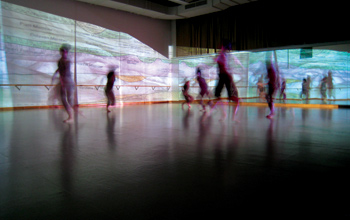Multimedia Gallery
NCSA Aquifer Dance
For "Dance: Re-Imagining the Proscenium," performers executed choreographed and spontaneous dance moves to music composed by New York-based composer James Lo as they roamed throughout the University of Illinois' Krannert Center for the Performing Arts. The dancers were part of a November 2008 modern dance performance showcasing the area's reliance on the Mahomet Aquifer that flows deep beneath the ground. The performance's creator, Illinois dance professor Jennifer Monson, is interested in environmental issues.
This distinctive dance experience was executed with the assistance of numerous collaborators including some from the National Center for Supercomputing Applications' (NCSA) Advanced Visualization Lab. Jeffrey Carpenter, Robert Patterson and Stuart Levy created visualizations like the one pictured here behind the dancers (created by Carpenter). This particular visualization depicts a persistent ground of dark, shimmering sand perpetually in motion, evoking the opaque and porous substrates of the aquifer through which water moves and from which it is drawn. Slowly, an isomorphic image of the aquifer rises and turns to open, inviting viewers to move within the exposed mystery of its negative space. Then, gradually a graphic representation of the aquifer resolves until it is superimposed across the 3D outlines of the aquifer. The images linger only a short time until the reality of the aquifer -- dense, dark and subterranean -- is reasserted.
The visualizations were projected on the rear walls of stages and rooms and around corners, surrounding and immersing the dancers and the audience and expanding their experience into new dimensions.
The performance was part of the Institute for Advanced Computing Applications and Technologies computing and creativity research theme, which is exploring, among other things, the use of new technology for creating innovative performances. (Date of Image: November 2008)
Credit: Background visualization by Jeffrey Carpenter, NCSA/University of Illinois; photo by Robert Patterson, NCSA/University of Illinois
See other images like this on your iPhone or iPad download NSF Science Zone on the Apple App Store.
Images and other media in the National Science Foundation Multimedia Gallery are available for use in print and electronic material by NSF employees, members of the media, university staff, teachers and the general public. All media in the gallery are intended for personal, educational and nonprofit/non-commercial use only.
Images credited to the National Science Foundation, a federal agency, are in the public domain. The images were created by employees of the United States Government as part of their official duties or prepared by contractors as "works for hire" for NSF. You may freely use NSF-credited images and, at your discretion, credit NSF with a "Courtesy: National Science Foundation" notation.
Additional information about general usage can be found in Conditions.
Also Available:
Download the high-resolution JPG version of the image. (9.7 MB)
Use your mouse to right-click (Mac users may need to Ctrl-click) the link above and choose the option that will save the file or target to your computer.

